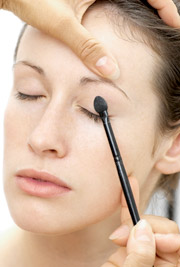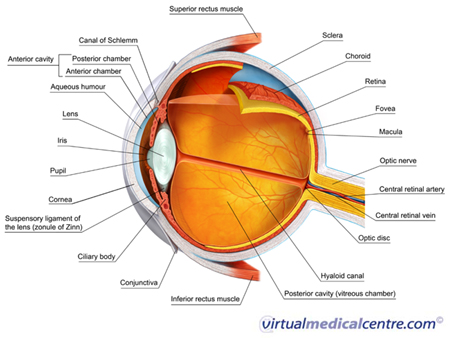- Introduction to eye health
- What to eat for bright healthy eyes
- How smoking affects your eyes
- Protecting eyes from the sun
- Healthy eyes in manufacturing, construction and outdoor workplaces
- Healthy eyes in office environments
- Eye exercises
- Choosing and using eye cosmetics
- Facial hygiene for eye health
- The benefit of eye health checks
- Keeping the body fit for healthy eyes
Introduction to eye health

However the eyes are very sensitive instruments which become damaged if they are exposed to too much light or other toxic substances (e.g. smoke in the environment, chemicals in cosmetic products). They are also dependent on a range of vitamins and nutrients to maintain their proper function (e.g. vitamin A deficiency is the leading cause of preventable blindness amongst children in developing countries). There are therefore many ways in which the eyes can potentially be damaged, but also many measures an individual can take to protect against eye diseases and/or disorders.
What to eat for bright healthy eyes
The eyes, like all other organs of the body, depend upon nutrients, vitamins and minerals, to maintain their health and proper function. Thus, the types and quantities of foods an individual eats affects the health of their eyes, and eating the right foods can protect the eyes from a range of diseases and conditions. Preventing eye diseases is particularly important as many disorders are untreatable, cause eyesight to gradually deteriorate and therefore impact significantly on an individual’s quality of life. However many individuals are not aware that their nutritional habits affect the health of their eyes and are unsure which types of foods to eat to protect their eyes’ health. Some of the key factors in healthy eating for bright healthy eyes are:
- Eat plenty of fruit and vegetables which contain a wide range of vitamins and minerals that protect the eyes. For example leafy green vegetables (e.g. spinach) are a good source of vitamin A, and citrus fruits and tomatoes are rich in vitamin C;
- Reduce fat and increase fibre intake to prevent diabetes, a metabolic condition which commonly leads to diabetic eye disease;
- Maintain a healthy body mass index to prevent diabetes.
For more information, see Nutrition for Healthy Eyes.
How smoking affects your eyes
Most people know that tobacco smoke generated by an individual smoking a cigarette, pipe, or other tobacco product, can cause damage not only to the individual who is smoking, but also to other people who are exposed to their tobacco smoke. The health conditions most commonly associated with tobacco smoke exposure are cancers and cardiovascular disorders. However cigarette smoking and tobacco smoke exposure also play an important role in the development of eye diseases and disorders. Few people are aware of the dangers smoking poses to the eyes however numerous scientific studies have now demonstrated an association between smoking or passive smoking (i.e. being exposed to another person’s tobacco smoke) and an increased risk of eye disorders.
The best way to prevent the eye diseases associated with tobacco smoke exposure is to quit smoking and avoid being around others who are smoking.
For more information, see The Effect of Smoking on Eye Health.
Protecting eyes from the sun

- Wearing a broad brimmed hat;
- Wearing wrap around sunglasses.
For more information, see Sun Protection for the Eyes.
Healthy eyes in manufacturing, construction and outdoor workplaces
There are a range of agents which can cause eye diseases, disorders or injuries which are found in workplaces. While many of these agents are often also found in everyday living environments exposure at dangerous levels is most likely to occur in the workplace, and thus these conditions are commonly referred to as work-related eye injuries or diseases. Excluding eye disorders related to computer use which are covered separately, work related eye diseases and disorders predominately affect individuals working outdoors or in the construction, manufacturing and service industries. Thus individuals who work in these industries should take measures to protect their eyes, including:
- Wearing protective eye wear, for example goggles to protect from invasion of foreign objects or sunglasses to protect from UV exposure;
- Rinsing eyes immediately if they are exposed to chemicals or other toxic substances.
For more information, see Eye Injuries in the Workplace.
Healthy eyes in office environments
The use of computers amongst office workers has increased markedly over the past two decades. This has resulted in an increase in health disorders associated with computer use, the most common of which are eye and vision problems. While eye health problems related to computer use are temporary, they cause significant discomfort to computer users and are largely preventable. Individuals who spend a significant amount of time using a computer each day should:
- Take regular breaks and perform simple eye exercises;
- Ensure their workstation is properly set up and the computer screen is at eye level;
- Ensure their computer screen is free of glare and the images displayed are clear and do not flicker.
For more information, see Office Ergonomics: Preventing Eye Strain.
Eye exercises
Visual training is the practice of exercising the eyes. Visual training can be performed to vision disorders, in particular disorders relating to binocular function (i.e. the misalignment of the eyes). Eye exercises are also commonly used to relieve eyes after long period of focused vision (e.g. computer use).
For more information, see Visual Training for Eye Disorders.
Choosing and using eye cosmetics

For more information, see Eye Cosmetics.
Facial hygiene for eye health
Bacteria, dirt and other foreign particles on the face can sometimes come into contact with the eye’s surface. Everyday dirt from a garden, soiled clothing, hair or a kitchen bench may also contain chemicals and bacteria. Exposure of the eyes’ surface to these foreign substances can therefore lead to irritations or infections. While these conditions are typically temporary and minor, poor facial hygiene is also associated with serious eye disorders which can cause permanent blindness. Preventing eyes from exposure to dirt and foreign particles is therefore important and can be achieved largely through maintaining good facial hygiene.
The benefit of eye health checks
Eye examinations, sometimes referred to by professionals as visual field tests, are eye investigations performed to detect vision abnormalities or monitoring changes in vision. Having eyes examined regularly is the best method by which individuals can detect changes to the visual field and diagnose the condition/s underlying such changes. Such detection enables early intervention and treatment of emerging conditions, which is typically essential in preventing worsening of symptoms (e.g. vision loss). As many eye diseases remain asymptomatic until vision loss begins, eye examinations are often the only means of detecting eye problems early.
For more information, see Eye Examinations.
Keeping the body fit for healthy eyes
The role of exercise in promoting good health is well known, particularly in relation to preventing cardiovascular disorders, diabetes and obesity. The role of exercise in protecting eye health is relatively little known in the general population and there is also a lack of evidence from scientific studies demonstrating the role of physical exercise in protecting the eyes from vision loss and other disease. Available evidence suggests however, that regular physical activity can protect the eyes from a number of disorders. There is also evidence that exercise protects against cardiovascular disease (a disease which shares many common risk factors with age related macular degeneration, the eye disease which is the leading cause of blindness in Australia) and obesity (which is associated with greater severity of vision loss).
References
- Marieb EN. Chapter 8: Special senses. In: Essentials of Human Anatomy and Physiology. San Francisco: Pearson Education; 2003.
- Lois N, Abdelkader E, Reglitz K, et al. Environmental tobacco smoke exposure and eye disease. Br J Ophthamol. 2008; 92(10): 1304-10.
- World Health Organisation. Vitamin A deficiency [online]. 2009 [cited 15 April 2009]. Available from: URL link
- American Optometric Association. Diet and nutrition [online]. 2006 [cited 15 April 2009]. Available from: URL link
- Cancer Council Australia. Eye protection from ultraviolet radiation [online]. 2006 [cited 15 April 2009]. Available from: URL link
- Peate WF. Work-related eye injuries and illnesses. Am Fam Physician. 2007; 75(7): 1017-24.
- American Federation of State, County and Municipal Employees (AFL-CIO). The keys to healthy computing: A health and safety handbook. 4 January 2007 [cited 15 April 2009] Available from: URL link
- Helveston EM. Visual training: Current status in ophthalmology. Am J Ophthalmol. 2005; 140(5): 903-10.
- United States Food and Drug Administration. Eye cosmetics and eyebrow/eyelash dyes [online]. 2001 [cited 15 April 2009]. Available from: URL link
- Optometrists Association of Australia. Visual field testing [online]. November2005 [cited 15 April 2009]. Available from URL link
- American Academy of Ophthalmology. Preferred practice pattern guidelines: Comprehensive adult medical eye evaluation. San Francisco, CA: American Academy of Ophthalmology, 2005. Available from URL link
- Williams PT. Prospective study of incident age-related macular degeneration in relation to vigorous physical activity during a 7-year follow-up. Invest Ophthalmol Vis Sci. 2009; 50(1): 101-6.
- Chiu CJ, Milton RC, Gensler G, Taylor A. Association between dietary glycemic index and age-related macular degeneration in nondiabetic participants in the Age-Related Eye Disease Study. Am J Clin Nutr. 2007, 86(1): 180-8.
- Seddon JM, Cote J, Davis N, Rosner B. Progression of age-related macular degeneration: Association with body mass index, waist circumference, and waist-hip ratio. Arch Ophthalmol. 2003; 121(6): 785-92.
All content and media on the HealthEngine Blog is created and published online for informational purposes only. It is not intended to be a substitute for professional medical advice and should not be relied on as health or personal advice. Always seek the guidance of your doctor or other qualified health professional with any questions you may have regarding your health or a medical condition. Never disregard the advice of a medical professional, or delay in seeking it because of something you have read on this Website. If you think you may have a medical emergency, call your doctor, go to the nearest hospital emergency department, or call the emergency services immediately.








